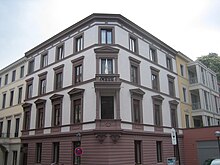Check mark

The Kästrich is an area in the Upper Town of Mainz and the name of a street that leads through the area. The current name is derived almost unchanged from the Latin word castrum for camp and points to the former location of the Roman legion camp in Mogontiacum . Part of the area (including the street of the same name) lies within the former city wall of Mainz and thus forms the only area within the city walls that does not belong to the Mainz-Altstadt district, although it is assigned to the old town zip code 55116.
Roman legionary camp of Mogontiacum
Today's "Kästrich" forms the northern part of the 13/12 BC. Roman legionary camp laid out on a hill by the general Nero Claudius Drusus . The terrain slopes steeply on its northeastern edge, so that the view of the Germanic area on the right bank of the Rhine was guaranteed.
The civil city ( canabae ) of Mogontiacum developed at the foot of this camp . Possibly the seat of the governor of the Roman province Germania superior , whose capital was Mogontiacum, was in the legionary camp and thus on the Kästrich .
In the 4th century the legionary camp was abandoned and a new city wall was built, which has since separated the area known today as "Kästrich" from the greater part of the former camp. The course of this wall formed the southwest border of the city of Mainz until modern times.
Middle Ages to the 19th century
From the Merovingian period to modern times, the area of the Kästrich remained undeveloped area within the Roman wall ring, which was restored and expanded from the Carolingian period. The slope was used as a vineyard . The noble Hôtel particuliers Bassenheimer Hof and Schönborner Hof am Thiermarkt (today Schillerplatz ) and the Altmünster and Welschnonnen monasteries had their baroque gardens facing the slope of the Kästrich. In the southeast stood the Martinsturm and the Gaupforte (later the Gautor ), the southern wall passage towards Alzey .
Development
The site was not built on again until 1845. At this point in time, Emmerich-Josef-Strasse was also built in the northeast of Kästrich. A new building for the Schöfferhof-Dreikönigshof beer brewery was built at the beginning of the development . In 1850, Christian Adalbert Kupferberg had the deepest layered sparkling wine cellar in the world built by simply walling up the slope, creating the Mathilde Terrace (named after Grand Duchess Mathilde of Hesse and by the Rhine ), now the Kupferberg Terrace. In 1856 the Mainz shares beer brewery was opened right next door . The Vincenzverein and Elisabethenverein emerged at the suggestion of the first German Catholic Day in Mainz in 1848 and in 1849 made the decision to build a hospital and provide nursing to the Sisters of Charity of St. To entrust Vincent de Paul from Strasbourg. This first St. Vincenz Hospital was built on the Kästrich after it had first found a place in the old town of Mainz (Weißliliengasse).
On November 18, 1857, the powder tower near the Gautore exploded , causing considerable damage to the entire city. District master builder Ignaz Opfermann took the necessary reconstruction measures as the occasion for a comprehensive planning of the Kästrich area. Terraces were laid out over the cellars of the brewery and the sparkling wine cellar; a large arched gate, framed by two flights of stairs, opens onto the city.
Housing complex on the Kästrich
In 1982 the Mainz shares brewery was given up. An architecture competition led to the planning of a luxurious residential complex (Büro Hentrich, Petschnigg und Partner). This blends in harmoniously with the surroundings; A broad front of the building with four generous arcades visually closes the copper mountain terrace below - at the same time, these arcades allow the view that was the reason for the establishment of the Roman camp at this point - and also of the city itself. A Roman city gate found during construction as well as the historical cellars below are integrated into the facility.
Individual evidence
- ↑ According to the main statute of the city of Mainz, §3 (13) or §3 (15) ( page no longer belongs to the side of the street Kästrich which is inward of the city) from the corner of Gaustraße to the first house to which a house number of the Kästrich is assigned retrievable , search in web archives ) Info: The link was automatically marked as defective. Please check the link according to the instructions and then remove this notice. to the old town.
literature
- Franz Dumont (ed.), Ferdinand Scherf , Friedrich Schütz : Mainz - The history of the city. Zabern, Mainz 1999 (2nd edition), ISBN 3-8053-2000-0
Web links
Coordinates: 49 ° 59 ′ 41.64 " N , 8 ° 15 ′ 50.83" E





